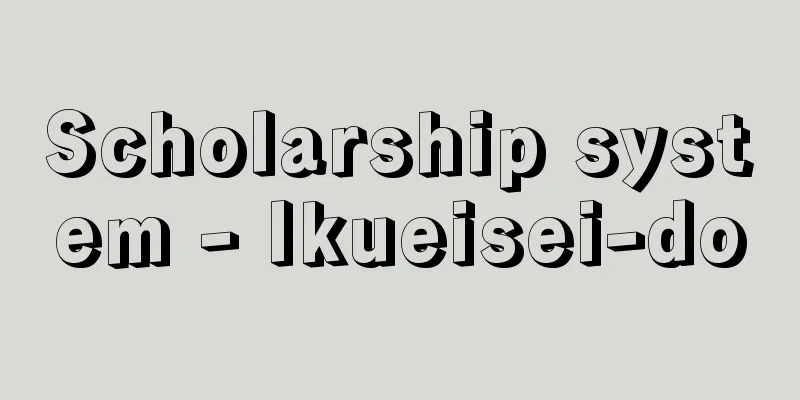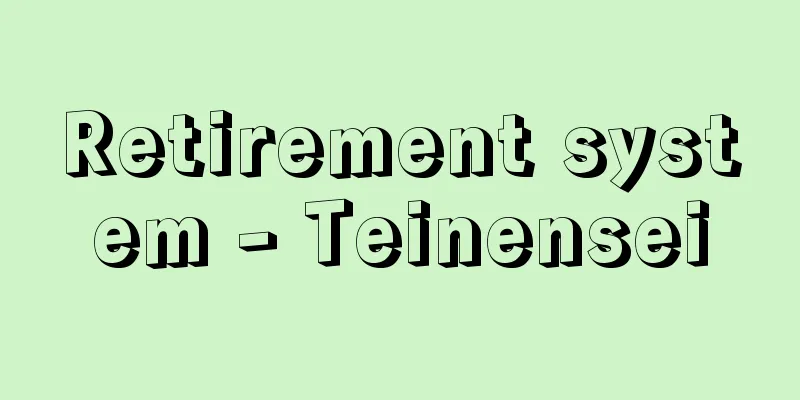Scholarship system - Ikueisei-do

|
The original meaning of "Ikuei" was "nurturing the gifted" and "securing human resources" that are in demand nationally and socially, and the Ikuei system is when public or private institutions provide "aid, loans, and other support for tuition fees" for that purpose. In Japan, it has been operated as a scholarship system for those in financial difficulty, under the condition "despite ability," and even when it is simply called the Ikuei system, it also has a strong significance of "ensuring educational opportunities" for those who have excellent ability but have difficulty studying for financial reasons. [Hiroshi Araki] Japan's scholarship systemIn Japan, there is an ancient system of kangakuden (training for students) that was established in the Ritsuryo era at Daigakuryo universities to train bureaucrats by providing food and clothing to students, but the first scholarship system since the Meiji era was the Konshinsei (student contribution) system established in 1870 (Meiji 3). This system allowed talented young men from each domain to enter university at the domain's expense, and aimed to develop human resources through Western learning, and at the time most domains are said to have had more than 300 Konshinsei (student contributions) but was abolished the following year in 1871 when the domains were abolished and prefectures were established. The 1872 (Meiji 5) "School System" established the scholarship system, which was based on the policy principle of the Japanese scholarship system that was later established, namely, the gifted, and aimed to guarantee educational opportunities to the economically disadvantaged. However, it is not clear to what extent this system was implemented, and it was abolished the following year in 1873, possibly for financial reasons. After that, scholarship programs were run only by private individuals, apart from the scholarship system at public normal schools, until the establishment of the Dai-Nippon Scholarship Foundation in 1943 (Showa 18). In other words, in the early Meiji period, scholarship programs were established by the former large feudal domains and mission schools, and finally in the latter half of the Meiji period, with the accumulation of capital and the expansion of the educational population, scholarship programs began to be run by prefecture-level programs, religious organizations, individuals, companies, etc. The number of these educational institutions reached approximately 80 by the end of the Meiji period, 382 by 1923 (Taisho 12), and further increased to 645 by 1943 (Showa 18). As militarism rapidly advanced in the 1930s and 1940s, the idea of guaranteeing educational opportunities was once again linked to the task of training human resources to achieve the national goal of building the Greater East Asia Co-Prosperity Sphere at the time, and there was a demand to establish a national scholarship system. The first national scholarship programs were launched by the aforementioned Dai Nippon Ikuei Kai, a foundation established in 1943 (it became a special corporation with the passage of the Dai Nippon Ikuei Kai Act in 1944, and was renamed Nippon Ikuei Kai in 1953 after World War II). The plan for the Dai Nippon Ikueikai's operations was to select a small number of talented students from among elementary school children who were financially unable to continue their education, and to reserve tuition loans, including living expenses, for junior high school, high school, and university. However, the poverty and inflation in the lives of the people after World War II made it urgent to provide financial assistance to students already enrolled in each school level, rather than reserving admissions for this small number of students, and so in 1948 (Showa 23), the system was changed to one of enrollment while enrolled, and the number of eligible students was expanded, with an emphasis on the higher education level. As prices continued to rise after the Second World War, scholarships had to be converted into programs that partially subsidized tuition fees. However, even in this situation, the Japan Scholarship Foundation continued to expand and diversify its scholarship programs by introducing new systems such as the following: (1) Graduate School Scholarship System This system was implemented in 1949 (Showa 24) when the jurisdiction of graduate school research scholarships, which had previously been under the Ministry of Education, was transferred to the Dai Nippon Ikuei Kai. (2) Education Scholarship System: This system was started in 1950 as a measure to secure teachers. It was aimed at students enrolled in compulsory education teacher training courses at national university teacher training departments who were considered to be of good behavior, had excellent academic records, and were physically strong, but who had difficulty paying for their tuition. If they continued to work in compulsory education after graduation, they were allowed to defer repayment of the scholarship for that period, and later it was expanded to include students enrolled in compulsory education teacher training courses at public and private universities. (3) Special Scholarship System: This system was introduced in 1958 for high schools, in 1961 for universities, and in 1964 for educational scholarship students. Each system provides higher amounts than the general loan amount. It was introduced as a reservation system for students who were "particularly outstanding" and wanted to continue to higher education, but who had "extremely difficult financial circumstances." If they paid back only the amount equivalent to the general loan, the remaining difference was exempt from repayment. Furthermore, when the foundation was renamed the Japan Scholarship Foundation in 1953 (Showa 28), the 10th anniversary of its founding, the exemption from repayment, which had previously only been applied to graduate school, teaching, and special scholarship recipients, was also introduced for general scholarship recipients (excluding high school scholarship recipients). Up until then, general scholarship recipients were generally granted loans based on the premise of a financial plan that involved the cyclical use of repayment funds, and at the time of its founding, exemption from repayment was only available in the event of the recipient's death, but with this change, in addition to cases of physical or mental disability, scholarship recipients will also be exempt from repayment in part or in whole if they find employment in a specific teaching or research position and remain in that position for a certain period of time. However, in 1984, the Japan Scholarship Foundation Law was completely revised, and while all previous scholarships were interest-free, an interest-bearing scholarship system was established to increase the loan rate. At the same time, the difference in the amount of interest-free scholarships between general and special loans was narrowing, and they were unified. At the same time, the education scholarship system was abolished due to changes in the supply and demand of teachers, and was absorbed into the general scholarship system. Previously, interest-free scholarships (Type 1) given to university faculties, junior colleges, and technical colleges were exempt from repayment if they continued to work in education for a certain period after completing their studies, as mentioned above, but in 1998, this exemption from repayment for those working in education was abolished, and it only remained for scholarships at graduate schools. From these trends of interest-bearing scholarships and reduction of exemption from repayment, we can see that the severe financial situation has forced changes in the quality of scholarship work. [Hiroshi Araki] current situationThe most important of Japan's scholarship programs is the scholarship system run by the Japan Scholarship Foundation. The overview of the program's status as of 2000 is as follows: Scholarships are divided into interest-free scholarships (Type 1 scholarships) and interest-bearing scholarships (Type 2 scholarships). Interest-free scholarships are offered at each level of school: high school, university, graduate school (master's and doctoral programs), technical colleges, and vocational colleges, while interest-bearing scholarships are offered at universities, graduate school master's programs, and vocational college specialized programs. Scholarship recipients are selected based on four criteria: academic ability, character, health, and household finances. The amount of the loan, for example, for interest-free scholarships at undergraduate universities, is 41,000 yen per month for students attending national and public universities who live at home and 47,000 yen per month for students who commute from anywhere, and 50,000 yen per month for students attending private universities who live at home and 60,000 yen per month for students who commute from anywhere. For interest-bearing scholarships, students at undergraduate universities can choose from 30,000 yen, 50,000 yen, 80,000 yen, or 100,000 yen per month, with an interest rate of 3% per year. The ratio of recipients of Japan Student Services Organization scholarships to the total number of students enrolled at each level of education in 1999 (Heisei 11) was 7.4% for undergraduates, 25.2% for master's programs, and 56.7% for doctoral programs for interest-free scholarships, and 7.2% for undergraduates and 14.7% for master's programs for interest-bearing scholarships. Public scholarship programs other than the Japan Scholarship Foundation include scholarships run by local governments such as Tokyo Metropolitan Government for people who live or are from the area, and publicly funded student loan programs for special purposes based on individual laws (for example, the Maternal and Child Welfare Student Loan, the Childcare Worker Student Loan, the Nurse Student Loan, the Care Worker Student Loan, the Correctional Medical Officer Student Loan, and the Public Health Student Loan). Many of the school-specific scholarship programs are run by universities, and since 1976, when a school corporation provides student loans to its current students, the government has provided long-term, low-interest loans and subsidies for the funds from the national treasury (Private School Promotion Subsidy Law, Article 8), and the number of universities offering this program is increasing. The number of educational programs run by private organizations dropped sharply during the economic turmoil following the Second World War, but gradually increased as the economy recovered. These programs are diverse, including those run by various foundations, companies, and specific religious organizations. One such program is run by the Association for the Educational Support of Children Orphaned in Traffic Accidents, which targets students who are financially unable to continue their studies because their parents have died or become permanently disabled in traffic accidents. [Hiroshi Araki] Scholarship system for studying abroadThere are government-funded scholarships for students who wish to study abroad in major countries, but the one that has been the most successful in Japan is the Fulbright Scholarship Program in the United States. This was launched in the United States in 1946 after the Second World War as an exchange program scholarship program to deepen mutual understanding with countries around the world through people-to-people exchanges, and is called the Fulbright Exchange Program (Program) or Fulbright Scholarship after its proponent, Fulbright (then a Senator). In Japan, people-to-people exchanges began under this program in 1952 (Showa 27), and were initially run by the United States Board of Education in Japan and the American government, but in 1979 (Showa 54), under the Japan-U.S. Educational Commission, which was established by both countries, the basic operating funds became shared between the two governments. Since then, in addition to providing financial assistance for the specialized research of each scholarship student, the program has also fostered leaders who will contribute to mutual understanding between Japan and the United States by sending 60 to 70 people from each country each year. To date, over 6,000 Japanese students (known as Fulbrighters) have benefited from this scholarship program and are now active in various fields after returning home. In addition, the Japanese government has its own scholarship program for overseas students, called the Short-Term Study Abroad Promotion Program. Under this program, when national universities (including graduate schools) enter into agreements with foreign universities on student exchanges and send a number of students allocated by the government, the government provides scholarships and travel expenses to those students for a period of up to one year. Next, there are various types of government-sponsored international students, where scholarships are provided by the Japanese government to international students, such as undergraduate students, graduate-level research students, Japanese language and culture studies students, technical college students, and vocational school students. The number of recipients is determined by country, and during the designated study period, government-sponsored international students at national universities and other institutions are exempt from tuition fees, while tuition fees are paid by the Japanese government for public and private universities. Finally, tuition fees are also waived for international students (agreement students) who are based on university or faculty exchange agreements concluded between national universities and foreign universities with the aim of promoting international exchange of students. Many universities other than national universities also have their own student exchange programs that waive tuition fees. [Hiroshi Araki] Scholarships in foreign countriesIf we limit our focus to the higher education level, the main characteristic cases are as follows: In the United States, the Federal Government established the Educational Opportunity Scholarship System under the Higher Education Act (1965), which is now called the Pell Grant and forms the basis of the scholarship system. Other major scholarships include the Perkins Loan, which is a loan from the Federal Government provided through the financial aid department of universities, and the Stafford Loan, which is a direct loan from the Federal Government or a guarantee for loans from private financial institutions by the Federal Government. Of these, Pell Grants alone account for approximately half of all undergraduate students. In the UK, part-time work by students is not encouraged, so scholarships are calculated by subtracting the amount that the student, parents, spouse, etc. can afford from the standard cost of living set by the government (a minimum guarantee amount is also set), and since the Education Act of 1962, scholarships have been paid to more than 90% of students (two-thirds of which are government-funded) through local education authorities. In Germany, the Federal Education Aid Act (enacted in 1976) established a scholarship system, and it became a legal right to request the payment of the amount of necessary expenses minus the amount that the individual can afford. Since then, scholarships have been provided by each state under contract with the federal government, but with the amendment of the Federal Education Aid Act in 1990, the previous full loan system was changed to a half-pay, half-loan system. [Hiroshi Araki] assignmentThe problems with the Japanese scholarship system compared to foreign scholarship systems are: (1) the low rate of recipients, (2) the small amount of scholarship money, and (3) the system is based on a loan system rather than a grant system, and an interest-bearing system is used. After the Second World War, it was guaranteed in Japan that "all people shall have the right to receive an equal education according to their ability, as provided by law" (Article 26 of the Constitution of Japan), and in particular, it has been stated that "the state and local public entities shall provide scholarships for those who, despite their ability, have difficulty studying for economic reasons" (Fundamental Law of Education, Article 3, Clause 2). However, the phrase "according to ability" in Article 26 of the Constitution of Japan is no longer interpreted as a meritocracy today, and correspondingly, the phrase "despite ability" in Article 3, Clause 2 of the Fundamental Law of Education is no longer interpreted as stipulating scholarship programs in a gifted-only manner. It can be said that there are expectations for the scholarship system to be actively improved, with a focus on the significance of guaranteeing educational opportunities. [Hiroshi Araki] "Japan Ikuei Society, edited and published, Collection of Data on Foreign Scholarship Systems, Vol. 3 (1971)" ▽ "Japan Ikuei Society, edited and published, 30-Year History of Japan Ikuei Society (1974)" ▽ "Japan Private University Association, Student Affairs Division, edited, New Theory on Scholarship Systems -- For the Development of Higher Education in Japan (1991, Kaisei Publishing)" ▽ "Japan Ikuei Society, edited and published, 50-Year History of Japan Ikuei Society (1993)" ▽ "Ministry of Education, edited, International Comparison of Education Indicators, various editions (Published by the Printing Bureau of the Ministry of Finance, from the 2001 edition published in January 2001, compiled by the Ministry of Education, Culture, Sports, Science and Technology and published by the Printing Bureau of the Ministry of Finance)" [References] |Right | |Source: Shogakukan Encyclopedia Nipponica About Encyclopedia Nipponica Information | Legend |
|
元来の育英とは、「英才の育成」および国家的、社会的に需要される「人材の確保」の意味をもち、育英制度とは、そのために公的または私的な機関が「学資の給・貸与その他の援助」を行うことである。日本では、それが経済的困窮者に対する奨学制度(奨学金制度)として、「能力があるにもかかわらず」という条件のもとに運用されてきて、単に育英制度と称される場合でも、優れた能力をもちながら経済的理由で修学困難な者への「教育機会の保障」の意義をも強くもつ。 [荒木 廣] 日本の育英制度日本において、古くは律令(りつりょう)時代の大学寮でその入学者に衣食を給して官僚の養成にあたった勧学田の制があるが、明治以降の育英制度の初めは1870年(明治3)制定の貢進生制度である。各藩から藩の負担で優れた青年を大学に入学させ、洋学を通して人材の育成を図るもので、当時ほとんどの藩から300人以上の貢進生があったとされるが、翌1871年の廃藩置県により廃止された。 1872年(明治5)の「学制」では、その後遅れて整備される日本の育英制度の政策原理、すなわち英才主義を基本としつつ経済的困窮者に教育機会を保障しようとする給貸費生制度が設けられた。しかしこの制度がどの程度に実施されたかは明らかでなく、財政上の理由からか翌1873年には廃止されている。その後の育英事業は、1943年(昭和18)の財団法人大日本育英会の設立までは、官公立師範学校などにおける給貸費生制度のほかは、民間の手によって進められただけである。すなわち、明治前期には旧大藩やミッション・スクールによる育英事業が成立し、明治後半期にようやく資本の蓄積と教育人口の拡大に伴い、府県単位の事業や宗教団体によるもののほか、個人や企業などによって育英事業がなされるようになった。これらの育英事業の主体は明治末期に約80に達し、1923年(大正12)には382、さらに1943年(昭和18)には645を数えるに至った。 昭和10年代に入ると急速に軍国主義化の進むなかで、改めて教育の機会保障理念と、当時の大東亜共栄圏建設という国家目的達成のための人材養成課題とが結び付けられて国家的育英制度の確立が要請され、1943年発足の前記財団法人大日本育英会(1944年の大日本育英会法成立により特殊法人となったあと、第二次世界大戦後の1953年日本育英会と改称)により、初めて国家的育英事業が開始された。 大日本育英会の事業は、計画としては、国民学校児童のなかから優秀かつ経済的理由によって修学困難な者を少数だけ精選し、中学校、高等学校、大学を通しての生活費までを含む学費貸与の予約をするものであった。しかし第二次世界大戦後の国民生活の窮乏とインフレーションは、この少数者への予約採用の計画よりも、各学校段階の既在学生への学資援助を急務とし、1948年(昭和23)から在学採用方式に切り替えられ、それとともに対象枠も高等教育段階を重点として拡大された。 このように第二次世界大戦後の物価高騰が続くなかでは、奨学金貸与額は学費の一部補助的な性格のものへと転換せざるをえなかったが、この状況下でも大日本育英会の奨学事業は以下のような制度が新たに導入され、拡充、多様化の措置がとられていった。 (1)大学院奨学生制度 従来文部省所管であった大学院研究奨学生の大日本育英会への移管によって1949年(昭和24)から実施。 (2)教育奨学生制度 1950年(昭和25)から教員確保のための施策として開始。国立大学教員養成学部の義務教育教員養成課程の在学生で品行方正、学術優秀、身体強健とされながら、学資の支弁が困難な者を対象とする。卒業後、引き続き義務教育に従事する場合は、その期間奨学金の返還は猶予され、のちには公私立大学の義務教育教員養成課程の在学者にも対象が拡大された。 (3)特別奨学生制度 1958年(昭和33)から高校で、1961年から大学で、さらに1964年からは教育奨学生に対しても開始された制度で、それぞれ一般貸与額より高額。「特ニ優秀」で進学を希望しながら「経済的理由ニ因リ著シク修学困難」な者に対する予約採用制として導入され、一般貸与相当額のみ返還すれば残りの差額は返還免除される。 さらに、創立10周年にあたる1953年(昭和28)に現在の日本育英会と改称された際、それまで大学院奨学生、教育奨学生、特別奨学生についてのみ適用された返還免除措置が、一般の奨学生(高校の奨学生を除く)に対しても整備導入された。これまで一般の奨学生は、返還金の循環運用という資金計画の建て前から貸与方式が原則で、創立当初は本人死亡の場合にのみ返還免除措置がとられていたが、この整備により心身障害が生じた場合のほか、奨学生が特定の教育・研究職に就職し、一定期間在職した場合、その一部または全部についての返還が免除されることとなった。 しかし、1984年(昭和59)の日本育英会法の全面改正により、従来いずれの奨学金も一貫して無利子であったのに対し、貸与率の拡大を目的として有利子奨学金制度が新設された。それとともに、これまでの無利子奨学金における一般貸与・特別貸与奨学金の金額差が少なくなってきたこともあって、それらが一本化された。また同時に、教員需給関係の変化から教育奨学生制度も廃止され、一般奨学生枠に吸収されることになった。従来、大学学部、短期大学および高等専門学校で貸与を受けた無利子奨学金(第1種)については前記のように修業後一定期間継続して教育の職にあれば返還が免除されたが、1998年(平成10)にはこの教育職従事に対する返還免除措置は廃止され、大学院における奨学金に対してのみ存続することとなった。このような、有利子奨学金の導入や返還免除措置縮小の動向からは、厳しい財政状況の影響によって育英事業の変質が余儀なくされてきた姿をみることができる。 [荒木 廣] 現状日本の育英事業のなかで、もっとも重要なものは日本育英会による育英制度であり、2000年(平成12)時点での事業状況を概観すれば次のとおりである。 奨学金は無利子の奨学金(第1種奨学金)と有利子奨学金(第2種奨学金)とに分けられ、無利子奨学金は高等学校、大学、大学院(修士課程・博士課程)、高等専門学校、専修学校の各学校段階で貸与、有利子奨学金は大学、大学院修士課程、専修学校専門課程で貸与されている。奨学生の選考は、学力、人物、健康、家計、の四つの基準によりなされているが、その貸与額は、たとえば大学学部における無利子奨学金は、国公立大学の場合、自宅通学者で月額4万1千円、自宅外通学者で月額4万7千円、私立大学の場合、自宅通学者で月額5万円、自宅外通学者で月額6万円である。また有利子奨学金は、大学学部の場合、月額3万円、5万円、8万円または10万円の中から選択するものとされ、その利率は年3%である。 それぞれの学校段階における在学者全体に対する日本育英会奨学金貸与者の1999年度(平成11)の比率(貸与率)は、無利子奨学金の場合、大学学部で7.4%、大学院修士課程で25.2%、博士課程で56.7%であり、有利子奨学金の場合、大学学部で7.2%、大学院修士課程で14.7%である。 日本育英会以外の公的奨学事業としては、東京都など各地方公共団体がその地域在住・出身者のために行っている育英奨学制度や、特殊な目的で個別の法令に基づき公費で実施されている修学資金貸与制度(たとえば母子福祉修学資金、保育士修学資金、看護師等修学資金、介護福祉士修学資金、矯正医官修学資金、公衆衛生修学資金など)がある。また、学校独自の育英事業は大学のものが多く、1976年(昭和51)以降、学校法人が在学学生・生徒に学資の貸与事業を行う場合、その資金への長期・低利の貸付および補助が国庫からなされるようになって(私立学校振興助成法8条)、この事業を行う大学が増えている。 民間団体による育英事業は第二次世界大戦後の経済混乱期に激減したのち、経済の復興とともに徐々に増加し、各種財団、企業によるもの、あるいは特定宗教団体によるものなど多様であるが、そのなかには保護者が交通事故で死亡または後遺障害者となったため、経済的に修学が困難な生徒・学生を対象とする財団法人交通遺児育英会による事業がある。 [荒木 廣] 留学に関する育英制度学生が外国に留学する場合、主要国の政府資金による留学奨学金制度があるが、日本で従来もっとも実績を積み重ねてきたものにアメリカのフルブライト奨学金制度がある。これは第二次世界大戦後の1946年に、人物交流により世界各国との相互理解を深めるための交流計画奨学金制度としてアメリカで発足し、提唱者であるフルブライト(当時上院議員)にちなんでフルブライト交流計画(事業)またはフルブライト奨学金と称される。日本では、1952年(昭和27)からこの計画の下に人物交流が始められ、当初は在日合衆国教育委員会およびアメリカの政府資金によって運営されてきたが、1979年(昭和54)に設立された両国運営による日米教育委員会の下で、その基本的運営資金も両国政府による折半出資となった。以来、奨学生それぞれの専門研究への財政援助だけでなく、日米の相互理解に貢献する指導者の育成を目的として、毎年両国側からそれぞれ60~70名の人物相互交流がなされ、これまでに6000名を超える日本人留学生(フルブライターFullbrighterとよばれる)がこの奨学金制度の恩恵に浴し、帰国後各界で活躍している。 また、日本政府が独自に援助する留学奨学金制度としては、短期留学推進制度による派遣奨学金制度がある。この制度では、国立大学(大学院を含む)が、外国の大学と学生交流に関する協定などを締結し国から割り当てられた数の学生を派遣する場合、その派遣学生に対し1年以内の期間に限定して政府から奨学金および旅費が支給される。 次に、外国人留学生に対し日本政府から奨学金が支給される国費外国人留学生制度には、学部留学生、大学院レベルの研究留学生、日本語・日本文化研修留学生、高等専門学校留学生、専修学校留学生など各種のものがある。その対象人数は国別に決められており、所定の留学期間中は、国立大学などの国費外国人留学生は授業料などが免除され、公・私立大学などの場合は日本政府が授業料を負担している。 最後に、国立大学と外国の大学との間で学生の国際交流を促進することを目的として締結された、大学間または学部間交流協定に基づく外国人留学生(協定留学生)についても授業料などが免除されている。なお、国立大学以外においても授業料などの免除を伴う、独自の留学生交換制度が多く実施されている。 [荒木 廣] 外国の育英制度高等教育段階に限定しておもな特徴的事例をみれば次のとおりである。 アメリカでは、高等教育法(1965)のもとで連邦が直接行う教育機会奨学金給与制度を確立させ、現在その名称がペル給費奨学金となって奨学金制度の基本を構成している。また連邦政府からの資金貸与を大学の経済援助部局を通して行うパーキンス貸与奨学金、連邦政府が直接に貸与したり民間金融機関からの貸与に対してその保証を連邦政府が直接・間接に行うスタフォード貸与奨学金制度も主要なものである。このうちペル給費奨学金だけでも学部学生の約半数がその受給者となっている。イギリスでは、学生のアルバイトが好まれないので、国の定める標準生活費から学生本人、親、配偶者などの負担可能額を差し引いた分が奨学金とされ(最低保障額も定められている)、1962年教育法以来、地方教育当局を通して(その3分の2は国費)学生の90%以上に給与されている。ドイツでは、連邦教育助成法(1976年施行)により奨学金制度が整備され、必要経費から個人負担可能額を差し引いた額の支給を求めることが法的権利とされた。以来、奨学金支給は連邦政府の委託により各州が実施しているが、1990年の連邦教育助成法の改正により、それまでの全額貸与制は半額給与・半額貸与制となった。 [荒木 廣] 課題外国の育英奨学制度と比較した日本の当該制度の問題点は、(1)奨学生率が低率であること、(2)奨学金額が少額であること、(3)給費方式ではなく貸与方式が基本であり、かつ有利子方式が導入されていることである。 第二次世界大戦後、日本においては「すべて国民は、法律の定めるところにより、その能力に応じて、ひとしく教育を受ける権利を有する」(日本国憲法26条)ことが保障され、とくに「国及び地方公共団体は、能力があるにもかかわらず、経済的理由によって修学困難な者に対して、奨学の方法を講じなければならない」(教育基本法3条2項)とされてきた。ただし、日本国憲法第26条の「能力に応じて」は、今日、能力主義的には解されず、それに対応して教育基本法第3条2項の「能力があるにもかかわらず」も、英才主義的に奨学事業を規定するものとは解されなくなってきている。育英制度はますます教育機会保障の意義を中心とした、積極的な充実が期待されているといえる。 [荒木 廣] 『日本育英会編・刊『外国奨学制度資料集 第3集』(1971)』▽『日本育英会編・刊『日本育英会30年史』(1974)』▽『日本私立大学連盟学生部会編『新・奨学制度論――日本の高等教育発展のために』(1991・開成出版)』▽『日本育英会編・刊『日本育英会50年史』(1993)』▽『文部省編『教育指標の国際比較』各年版(大蔵省印刷局、2001年1月発行の平成13年度版より文部科学省編、財務省印刷局発行)』 [参照項目] | | |出典 小学館 日本大百科全書(ニッポニカ)日本大百科全書(ニッポニカ)について 情報 | 凡例 |
Recommend
Hannoversch-Munden (English spelling)
…A river that flows roughly north-south through c...
Far Eastern Advisory Committee - Kyokutoushimoniiinkai
...A policy-making body for Japan established in ...
Duvet (English spelling) (French) duvet
A feather duvet (meaning bird fluff) or a bed cove...
arachnoidea
…In the brain, these two membranes are mostly fus...
The Era of the Righteous Caliphs - Seitokarifujidai
This refers to the period (632-661) ruled by four...
Council of India
…Furthermore, in the 1530s, the traditional trade...
A clear day - Ichinichibare
〘 noun 〙① Only on special days such as special vis...
Prince Niitabe
The seventh son of Emperor Tenmu. His mother was ...
Azuma pyroclastic flow
…The pyroclastic flow that erupted on the evening...
Preta (English spelling)
In Sanskrit, it means the dead or ancestors. Later...
Revenue tax - shuutokuzei
It is a general term for taxes on goods that indi...
Yonezawa Domain
This clan ruled the Okitama region of Dewa Provin...
National Bond Consolidation Fund Special Account
A special account established to cover expenses s...
Theoria
A Greek word meaning "seeing," "con...
Mud sampler - Saideiki
A device used to collect materials from the seabed...









